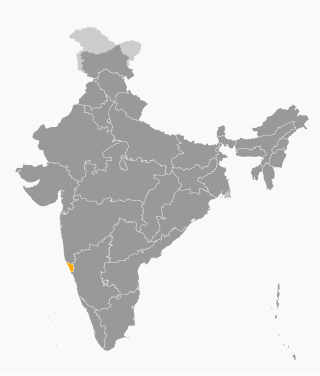
Canacona is an administrative region in the district of South Goa, Goa state, India.

Salcete or Salcette is a subdivision of the district of South Goa, in the state of Goa, situated by the west coast of India. The Sal River and its backwaters dominate the landscape of Salcete. Historically, the sixty-six settlements south of the Zuari River formed the original Salcette territory. Salcete forms a part of the bigger Konkan region that stretches along the western shoreline of peninsular India.

Navelim is a census town and fast growing suburb of the city of Margao located in the Salcete sub-district of South Goa district, Goa, India. It has a large parish and has played a crucial rule in South Goa politics at some stage. The region falls in the coastal South Goa sub-district of Salcete. It has been connected with some important persons from the world of Goan history too.
The island of Divar lies in the Mandovi river in the Indian state of Goa.

Chinchinim is a census town in Goa state, India. It is located in the Salcete taluka of South Goa district. Prior to achieving the current status of a small town, it was considered one of the biggest villages of southern Goa.
Loutolim or Loutulim is a large village of South Goa district in the state of Goa, India. It is an important settlement in the Salcete sub-district.

Verna is a village in Salcete, Goa, India, adjacent to the village of Nagoa. It is located approximately 10 km north of the South Goa district headquarters Margão, 18 km south-east of Vasco da Gama and 23 km south-east of the state capital Panjim.It has the hub of Verna Industrial Area where lot of people from different parts of India come to work in the production sector.
Fatorda is a suburb of the city of Margao in Salcete, Goa. Fatorda has been originally home to the traditional Scheduled Tribe/Scheduled Caste population. The Catholic Gawda community has a very large presence in Fatorda. However, due to the increasing number of buildings in Fatorda, the population has become more diverse.

Comba (Komb) is a town and suburb of the city of Margao in South Goa district in the state of Goa, India close to the city of Margao.
Raia is a quaint village in the Salcete taluka of South Goa district, Goa state, India. It is located 4 km (2.5 mi) east from the district headquarters of Margao and 35 km (22 mi) from the state capital Panjim.

Rachol is a prominent village in the Salcete taluka (subdistrict) of South Goa district, Goa state, peninsular India. It is located on the left bank of the Zuari River and is home to the famous Rachol Seminary. The famous Portuguese colonial Rachol Fort has been completely erased, leaving behind the traces of the moat and the main gate. The village has many heritage structures and is an important site to study the history of Salcete. The Church of Our Lady of Snows at Rachol is said to be the first church of Salcete and is called the Matriz igreja de Salcette. Ilha de Rachol is a part of the village.

Goa is a state on the southwestern coast of India within the Konkan region, geographically separated from the Deccan highlands by the Western Ghats. It is bound by the Indian states of Maharashtra to the north, and Karnataka to the east and south, with the Arabian Sea in the west. It is India's smallest state by area and fourth-smallest by population. Goa has the highest GDP per capita among all Indian states, two and a half times as high as the GDP per capita of the country as a whole. The Eleventh Finance Commission of India named Goa the best-placed state because of its infrastructure, and India's National Commission on Population rated it as having the best quality of life in India. It is the second-highest ranking among Indian states in the human development index.

Shri Damodar Temple Zambaulim or Shri Damodara Sansthaan is a Hindu temple on the bank of the Kushawati River near the village of Zambaulim 22 km from the city of Margao on the border of Quepem region in the south of Goa. The temple houses a celebrated murti, or image, of Shiva incarnated as Damodar.
Verna Railway Station is a railway station in Nagoa – Cansaulim Road, Verna, Salcete, South Goa, Goa.
Loliem Railway Station a railway station in Goa, under the jurisdiction of the Konkan Railway. It's the last railway station in South-West railway zone in the state of Goa in its southern end.
Suravali Railway Station is a smaller railway station in Goa.

The following outline is provided as an overview of and topical guide to Goa:

Regina Martyrum High School is a private aided co-educational school located within the Assolna village in Salcete taluka of Goa. It is administered by the Diocesan Society of Education, Panjim. The school is associated with the Goa Board of Secondary and Higher Secondary Education and the Directorate of Education, Goa. It prepares students for Std. X (S.S.C) examination. The first batch of S.S.C had appeared in March 1974.

Mount Mary's Higher Secondary School is a private aided co-educational higher secondary school located within Chinchinim in the Indian coastal state of Goa. It was established in 1996 and is affiliated to Department of Education, Goa and Goa Board of Secondary and Higher Secondary Education. The school also serves as a sub-centre of the Navelim main centre in the HSSC exams.








































